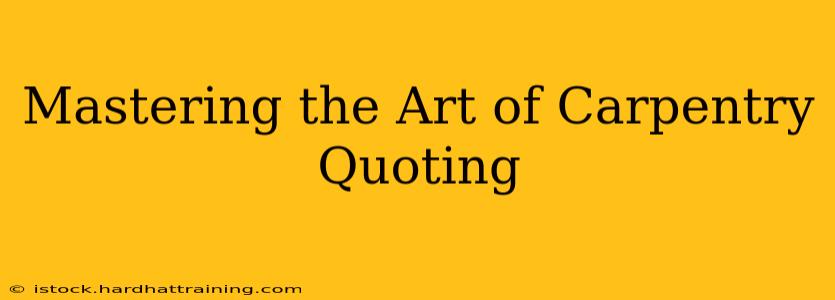Accurate and competitive carpentry quoting is crucial for success in the industry. It's not just about adding up material costs; it’s about understanding your expenses, pricing your skills fairly, and building lasting relationships with clients. This comprehensive guide will help you master the art of carpentry quoting, ensuring you’re profitable and your clients are satisfied.
What Factors Determine Carpentry Project Costs?
Before diving into the quoting process, it's vital to identify all cost factors. This ensures your quotes are accurate and reflect the true investment required for the project. Key elements include:
- Materials: This is the most straightforward aspect. Create a detailed list of all materials needed, sourcing the best prices from your suppliers. Remember to factor in waste and potential price fluctuations.
- Labor: This is where many carpenters underestimate their costs. Account for your hourly rate, including benefits, taxes, and insurance. Consider the complexity of the project and the time it will take.
- Equipment and Tools: Include costs associated with equipment rental or maintenance. If you're using your own tools, consider depreciation and regular maintenance.
- Overhead Costs: This covers business expenses like rent, utilities, vehicle expenses, and administrative costs. Allocate a percentage of your overhead to each project to reflect these indirect expenses.
- Profit Margin: This is crucial for your business's sustainability. Determine a reasonable profit margin that ensures profitability while remaining competitive. A healthy profit margin allows for reinvestment and growth.
- Travel Time and Mileage: For projects that require travel, account for the time spent travelling and mileage reimbursement, especially for projects outside your immediate area.
- Permits and Inspections: If required by local regulations, include the cost of permits and inspections in your quote. This can vary depending on the project's scale and location.
How to Accurately Estimate Labor Costs for Carpentry Projects?
Accurately estimating labor costs is a critical skill. Underestimating can lead to losses, while overestimating can make your bids uncompetitive. Here's how to approach it:
- Detailed Breakdown: Break down the project into smaller, manageable tasks. Estimate the time required for each task based on your experience and expertise.
- Consider Complexity: Factor in any unique challenges or complexities that might increase the labor time. A seemingly simple project could have hidden complexities that impact your time estimate.
- Contingency Planning: Always include a contingency buffer for unexpected issues or delays. This safeguards you against unforeseen circumstances.
- Track Your Time: Regularly track your time spent on various tasks to refine your estimations. This helps you develop a more accurate understanding of your labor costs.
How Much Should I Charge Per Hour for Carpentry Services?
Determining your hourly rate is crucial. Consider:
- Experience and Expertise: More experienced carpenters typically command higher rates.
- Market Research: Research the going rates in your area for similar carpentry services.
- Cost of Living: Your location will influence your hourly rate.
- Desired Income: Calculate the hourly rate needed to achieve your desired annual income, considering all costs.
What are the Common Mistakes to Avoid When Creating Carpentry Quotes?
- Underestimating Costs: This is the most frequent error. Thorough planning and accurate estimations are crucial.
- Ignoring Overhead: Many underestimate overhead costs, leading to financial difficulties.
- Neglecting Profit Margin: Always include a healthy profit margin to ensure business sustainability.
- Lack of Detail: A vague quote can lead to misunderstandings and disputes. Provide detailed descriptions of materials, labor, and other costs.
- Unclear Payment Terms: Clearly outline payment terms, milestones, and penalties for late payments.
How Can I Make My Carpentry Quotes Stand Out?
- Professional Presentation: Present your quotes professionally and clearly. Use templates to ensure consistency.
- Detailed Specifications: Include detailed descriptions of materials, finishes, and any other relevant information.
- Excellent Communication: Clearly communicate with clients, answering any questions promptly and professionally.
- Build Relationships: Focus on building strong relationships with clients based on trust and professionalism. This can lead to repeat business and referrals.
Mastering carpentry quoting requires experience and careful planning. By meticulously considering all cost factors, accurately estimating labor, and presenting your quotes professionally, you can secure projects, build a thriving business, and maintain satisfied clients. Remember, a well-crafted quote reflects your professionalism and commitment to quality.
